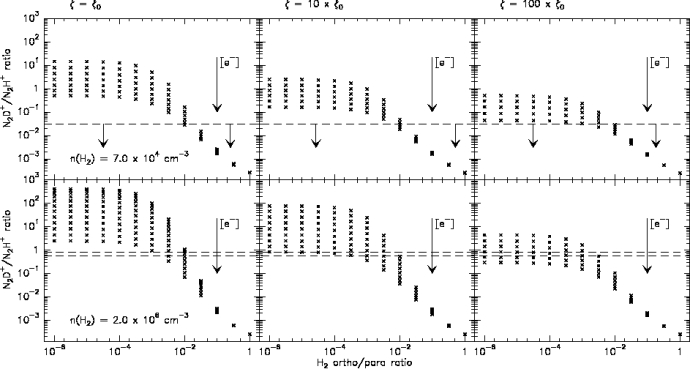| EPoS Contribution |
|
Deuteration of prestellar cores and the role of the ortho/para H2 ratio
Laurent P. Pagani LERMA, Observatoire de Paris, Paris, France | |
| It is now understood that the strong deuteration of species like ammonia (NH3) and methanol (CH3OH) are possible thanks to the fact that H3+ can be deuterated three times to produce D3+ in reasonable amounts and that the dissociative recombination of D3+ with electrons frees enough atomic deuterium in the gas phase to enrich ammonia or methanol to triply deuterated species like ND3 and CD3OH by grain surface reactions thanks to these numerous Deuterium atoms colliding these grains (eg. Roberts et al. 2003). However, Roberts et al. (2003) found that the mechanism was too efficient. This was because they ignored the role of ortho-H2 in limiting the efficiency of the Deuteration processes. We will show that this role is indeed a key aspect of this chemistry, that the ortho/para H2 ratio is measurable and could be a chemical clock to trace the collapse of the protostellar cores. | |
 | |
| Caption: Deuteration efficiency (i.e. N2D+/N2H+ ratio) as a function of the ortho/para H2 ratio for all possible electronic abundances and total depletion (for the steady-state chemical model). It is clear that for an o/p H2 ratio above ~1% whatever the general conditions, deuteration is vanishingly small. | |
| Collaborators: Pierre Lesaffre, LERMA, OdP & ENS, Paris, France C. Vastel, CESR, Toulouse, France E.Hugo, Universite Rennes, France V.Kokoouline, Central University of Florida, USA Chris H. Greene, University of Colorado, USA A. Bacmann, Obs. de Grenoble, France E. Bayet, Imperial College, London, GB C. Ceccarelli, LAOG, Grenoble, France S. Schlemmer, Küln Universität, Germany |
Key publication
Suggested Session: Chemistry, Cores and Collapse |

